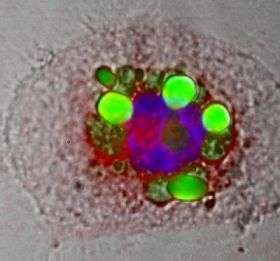Role of a key enzyme in reducing heart disease identified

Virginia Commonwealth University researchers have identified the role of a key enzyme called CEH in reducing heart disease, paving the way for new target therapies to reduce plaques in the arteries and perhaps in the future, help predict a patient’s susceptibility to heart disease.
Furthermore, unlike currently available therapies, which prevent or reduce the formation of new plaques, increasing CEH may also reduce existing plaques.
Heart disease results from the formation of plaques in the coronary artery, which supplies blood to the heart. Plaques form when monocytes, which are cells from the blood, enter the wall of the artery and consume large amounts of the “bad” cholesterol, or LDL. The monocytes then become artery-clogging foam cells. The only way for foam cells to get rid of their cholesterol is to make it available to HDL, or “good” cholesterol, for removal. A key enzyme present in the foam cells called cholesteryl ester hydrolase (CEH) regulates the amount of cholesterol that can be removed by HDL.
In this study, led by Shobha Ghosh, Ph.D., an associate professor of internal medicine, pulmonary division in the VCU School of Medicine, the team examined, for the first time, how cells in the artery wall make cholesterol available for removal by HDL. Using transgenic mice, which were fed a high fat and cholesterol-rich diet, the team was able to show that by increasing the removal of cholesterol from the artery clogging foam cells, the mice with the human gene for CEH developed significantly less heart disease.
“Currently the emphasis for managing heart disease is on reducing the “bad” cholesterol or LDL in the circulation. Our study demonstrates that if you can increase the removal of cholesterol from the plaques, even without changing the LDL levels, there is still a significant reduction in the plaques,” said Ghosh.
“These findings not only change the current thinking of managing heart disease but also clearly open avenues for the development of new therapies. By identifying CEH as a new therapeutic target, we expect that in the future patients with heart disease will have more options to aggressively treat heart disease. In addition, by determining the levels of CEH in human blood cells, we hope to be able to predict susceptibility to heart disease in the future,” she said.
According to Ghosh, the team focused their efforts on the examination of macrophage foam cells, which are responsible for storing large amounts of cholesterol and lead to the clogging of the arteries by forming plaques. The findings appear in the October print issue of the Journal of Clinical Investigation.
The team is actively exploring the mechanisms underlying CEH regulation and to determine how its activity can be increased in order to reduce heart disease.
Source: Virginia Commonwealth University





















